Shan Lu
School of Engineering, Nagoya University, Nagoya, Japan
Distance Estimation in Outdoor Driving Environments Using Phase-only Correlation Method with Event Cameras
May 23, 2025Abstract:With the growing adoption of autonomous driving, the advancement of sensor technology is crucial for ensuring safety and reliable operation. Sensor fusion techniques that combine multiple sensors such as LiDAR, radar, and cameras have proven effective, but the integration of multiple devices increases both hardware complexity and cost. Therefore, developing a single sensor capable of performing multiple roles is highly desirable for cost-efficient and scalable autonomous driving systems. Event cameras have emerged as a promising solution due to their unique characteristics, including high dynamic range, low latency, and high temporal resolution. These features enable them to perform well in challenging lighting conditions, such as low-light or backlit environments. Moreover, their ability to detect fine-grained motion events makes them suitable for applications like pedestrian detection and vehicle-to-infrastructure communication via visible light. In this study, we present a method for distance estimation using a monocular event camera and a roadside LED bar. By applying a phase-only correlation technique to the event data, we achieve sub-pixel precision in detecting the spatial shift between two light sources. This enables accurate triangulation-based distance estimation without requiring stereo vision. Field experiments conducted in outdoor driving scenarios demonstrated that the proposed approach achieves over 90% success rate with less than 0.5-meter error for distances ranging from 20 to 60 meters. Future work includes extending this method to full position estimation by leveraging infrastructure such as smart poles equipped with LEDs, enabling event-camera-based vehicles to determine their own position in real time. This advancement could significantly enhance navigation accuracy, route optimization, and integration into intelligent transportation systems.
Evaluation of Mobile Environment for Vehicular Visible Light Communication Using Multiple LEDs and Event Cameras
May 21, 2025Abstract:In the fields of Advanced Driver Assistance Systems (ADAS) and Autonomous Driving (AD), sensors that serve as the ``eyes'' for sensing the vehicle's surrounding environment are essential. Traditionally, image sensors and LiDAR have played this role. However, a new type of vision sensor, event cameras, has recently attracted attention. Event cameras respond to changes in the surrounding environment (e.g., motion), exhibit strong robustness against motion blur, and perform well in high dynamic range environments, which are desirable in robotics applications. Furthermore, the asynchronous and low-latency principles of data acquisition make event cameras suitable for optical communication. By adding communication functionality to event cameras, it becomes possible to utilize I2V communication to immediately share information about forward collisions, sudden braking, and road conditions, thereby contributing to hazard avoidance. Additionally, receiving information such as signal timing and traffic volume enables speed adjustment and optimal route selection, facilitating more efficient driving. In this study, we construct a vehicle visible light communication system where event cameras are receivers, and multiple LEDs are transmitters. In driving scenes, the system tracks the transmitter positions and separates densely packed LED light sources using pilot sequences based on Walsh-Hadamard codes. As a result, outdoor vehicle experiments demonstrate error-free communication under conditions where the transmitter-receiver distance was within 40 meters and the vehicle's driving speed was 30 km/h (8.3 m/s).
MAS-Attention: Memory-Aware Stream Processing for Attention Acceleration on Resource-Constrained Edge Devices
Nov 20, 2024Abstract:The advent of foundation models have revolutionized various fields, enabling unprecedented task accuracy and flexibility in computational linguistics, computer vision and other domains. Attention mechanism has become an essential component of foundation models, due to their superb capability of capturing correlations in a sequence. However, attention results in quadratic complexity in memory and compute as the context length grows. Although many fusion-based exact attention acceleration algorithms have been developed for datacenter-grade GPUs and accelerators leveraging multi-core parallelism and data locality, yet it remains a significant challenge to accelerate attention on resource-constrained edge neural accelerators with limited compute units and stringent on-chip caches. In this paper, we propose a scheme for exact attention inference acceleration on memory-constrained edge accelerators, by parallelizing the utilization of heterogeneous compute units, i.e., vector processing units and matrix processing units. Our method involves scheduling workloads onto these different compute units in a multi-tiered tiling scheme to process tiled vector workloads and matrix workloads in attention as two streams, respecting the workload dependencies. We search for tiling factors to maximize the parallelization of both compute units while considering I/O overhead, and propose a proactive cache overwrite strategy to avoid undesirable cache spills in reality. Extensive results based on open-sourced simulation frameworks show up to 2.75x speedup and 54% reduction in energy consumption as compared to the state-of-the-art attention fusion method (FLAT) in the edge computing scenario. Further experiments on a real-world edge neural processing unit demonstrate speedup of up to 1.76x for attention as compared to FLAT, without affecting model output accuracy.
DroidSpeak: Enhancing Cross-LLM Communication
Nov 05, 2024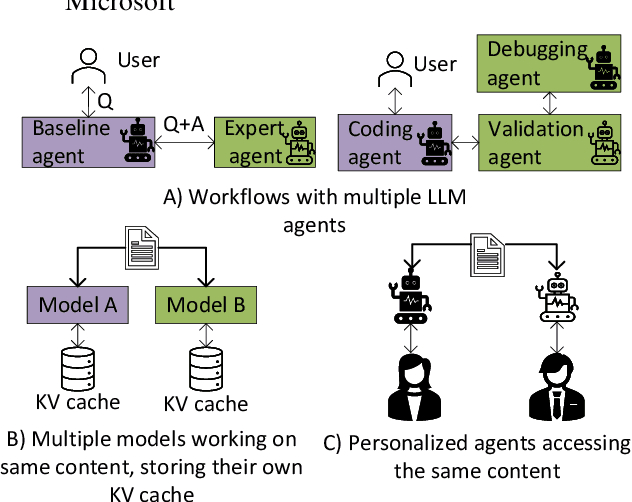
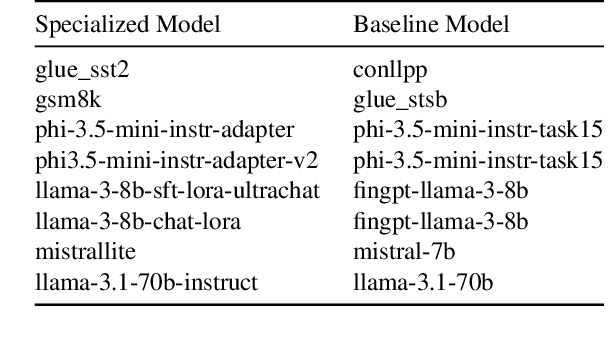
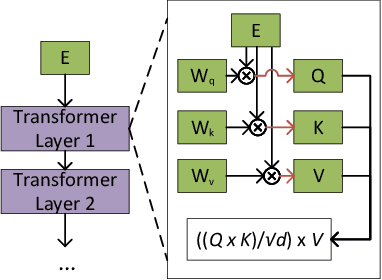

Abstract:In multi-agent systems utilizing Large Language Models (LLMs), communication between agents traditionally relies on natural language. This communication often includes the full context of the query so far, which can introduce significant prefill-phase latency, especially with long contexts. We introduce DroidSpeak, a novel framework to target this cross-LLM communication by leveraging the reuse of intermediate data, such as input embeddings (E-cache) and key-value caches (KV-cache). We efficiently bypass the need to reprocess entire contexts for fine-tuned versions of the same foundational model. This approach allows faster context integration while maintaining the quality of task performance. Experimental evaluations demonstrate DroidSpeak's ability to significantly accelerate inter-agent communication, achieving up to a 2.78x speedup in prefill latency with negligible loss in accuracy. Our findings underscore the potential to create more efficient and scalable multi-agent systems.
Automated Proof Generation for Rust Code via Self-Evolution
Oct 21, 2024



Abstract:Ensuring correctness is crucial for code generation. Formal verification offers a definitive assurance of correctness, but demands substantial human effort in proof construction and hence raises a pressing need for automation. The primary obstacle lies in the severe lack of data - there is much less proof than code for LLMs to train upon. In this paper, we introduce SAFE, a novel framework that overcomes the lack of human-written proof to enable automated proof generation of Rust code. SAFE establishes a self-evolving cycle where data synthesis and fine-tuning collaborate to enhance the model capability, leveraging the definitive power of a symbolic verifier in telling correct proof from incorrect ones. SAFE also re-purposes the large number of synthesized incorrect proofs to train the self-debugging capability of the fine-tuned models, empowering them to fix incorrect proofs based on the verifier's feedback. SAFE demonstrates superior efficiency and precision compared to GPT-4o. Through tens of thousands of synthesized proofs and the self-debugging mechanism, we improve the capability of open-source models, initially unacquainted with formal verification, to automatically write proof for Rust code. This advancement leads to a significant improvement in performance, achieving a 70.50% accuracy rate in a benchmark crafted by human experts, a significant leap over GPT-4o's performance of 24.46%.
CacheBlend: Fast Large Language Model Serving with Cached Knowledge Fusion
May 26, 2024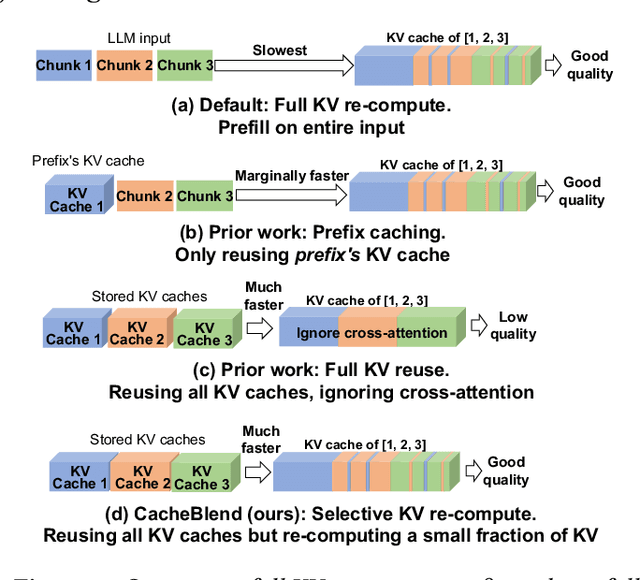
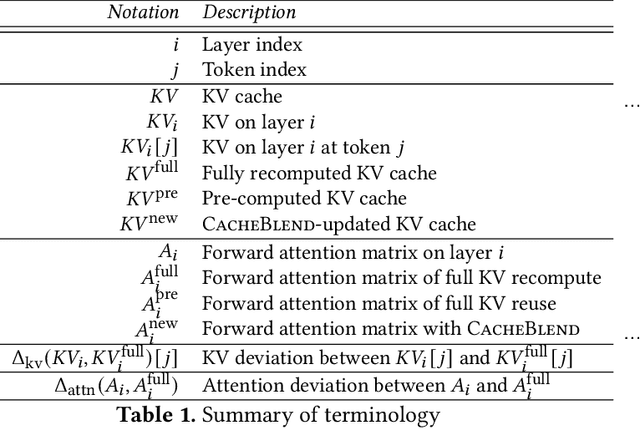
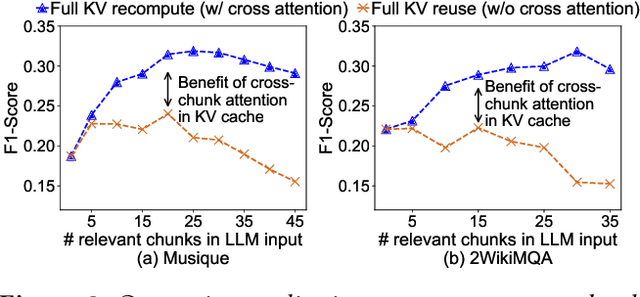
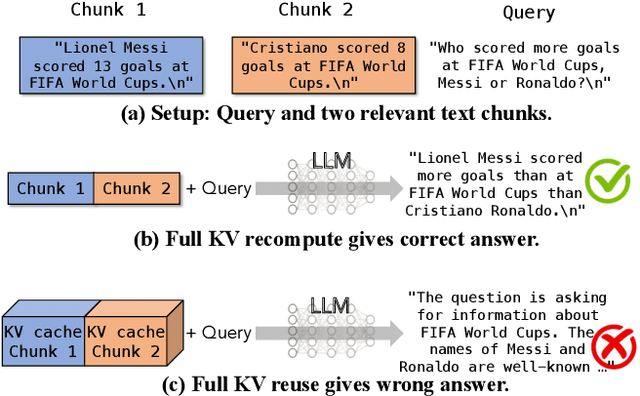
Abstract:Large language models (LLMs) often incorporate multiple text chunks in their inputs to provide the necessary contexts. To speed up the prefill of the long LLM inputs, one can pre-compute the KV cache of a text and re-use the KV cache when the context is reused as the prefix of another LLM input. However, the reused text chunks are not always the input prefix, and when they are not, their precomputed KV caches cannot be directly used since they ignore the text's cross-attention with the preceding text in the LLM input. Thus, the benefits of reusing KV caches remain largely unrealized. This paper tackles just one question: when an LLM input contains multiple text chunks, how to quickly combine their precomputed KV caches in order to achieve the same generation quality as the expensive full prefill (i.e., without reusing KV cache)? We present CacheBlend, a scheme that reuses the pre-computed KV caches, regardless prefix or not, and selectively recomputes the KV values of a small subset of tokens to partially update each reused KV cache. In the meantime,the small extra delay for recomputing some tokens can be pipelined with the retrieval of KV caches within the same job,allowing CacheBlend to store KV caches in slower devices with more storage capacity while retrieving them without increasing the inference delay. By comparing CacheBlend with the state-of-the-art KV cache reusing schemes on three open-source LLMs of various sizes and four popular benchmark datasets of different tasks, we show that CacheBlend reduces time-to-first-token (TTFT) by 2.2-3.3X and increases the inference throughput by 2.8-5X, compared with full KV recompute, without compromising generation quality or incurring more storage cost.
AGHINT: Attribute-Guided Representation Learning on Heterogeneous Information Networks with Transformer
Apr 16, 2024Abstract:Recently, heterogeneous graph neural networks (HGNNs) have achieved impressive success in representation learning by capturing long-range dependencies and heterogeneity at the node level. However, few existing studies have delved into the utilization of node attributes in heterogeneous information networks (HINs). In this paper, we investigate the impact of inter-node attribute disparities on HGNNs performance within the benchmark task, i.e., node classification, and empirically find that typical models exhibit significant performance decline when classifying nodes whose attributes markedly differ from their neighbors. To alleviate this issue, we propose a novel Attribute-Guided heterogeneous Information Networks representation learning model with Transformer (AGHINT), which allows a more effective aggregation of neighbor node information under the guidance of attributes. Specifically, AGHINT transcends the constraints of the original graph structure by directly integrating higher-order similar neighbor features into the learning process and modifies the message-passing mechanism between nodes based on their attribute disparities. Extensive experimental results on three real-world heterogeneous graph benchmarks with target node attributes demonstrate that AGHINT outperforms the state-of-the-art.
Type-based Neural Link Prediction Adapter for Complex Query Answering
Jan 29, 2024Abstract:Answering complex logical queries on incomplete knowledge graphs (KGs) is a fundamental and challenging task in multi-hop reasoning. Recent work defines this task as an end-to-end optimization problem, which significantly reduces the training cost and enhances the generalization of the model by a pretrained link predictors for query answering. However, most existing proposals ignore the critical semantic knowledge inherently available in KGs, such as type information, which could help answer complex logical queries. To this end, we propose TypE-based Neural Link Prediction Adapter (TENLPA), a novel model that constructs type-based entity-relation graphs to discover the latent relationships between entities and relations by leveraging type information in KGs. Meanwhile, in order to effectively combine type information with complex logical queries, an adaptive learning mechanism is introduced, which is trained by back-propagating during the complex query answering process to achieve adaptive adjustment of neural link predictors. Experiments on 3 standard datasets show that TENLPA model achieves state-of-the-art performance on complex query answering with good generalization and robustness.
RoKEPG: RoBERTa and Knowledge Enhancement for Prescription Generation of Traditional Chinese Medicine
Nov 29, 2023



Abstract:Traditional Chinese medicine (TCM) prescription is the most critical form of TCM treatment, and uncovering the complex nonlinear relationship between symptoms and TCM is of great significance for clinical practice and assisting physicians in diagnosis and treatment. Although there have been some studies on TCM prescription generation, these studies consider a single factor and directly model the symptom-prescription generation problem mainly based on symptom descriptions, lacking guidance from TCM knowledge. To this end, we propose a RoBERTa and Knowledge Enhancement model for Prescription Generation of Traditional Chinese Medicine (RoKEPG). RoKEPG is firstly pre-trained by our constructed TCM corpus, followed by fine-tuning the pre-trained model, and the model is guided to generate TCM prescriptions by introducing four classes of knowledge of TCM through the attention mask matrix. Experimental results on the publicly available TCM prescription dataset show that RoKEPG improves the F1 metric by about 2% over the baseline model with the best results.
MultiModal-Learning for Predicting Molecular Properties: A Framework Based on Image and Graph Structures
Nov 28, 2023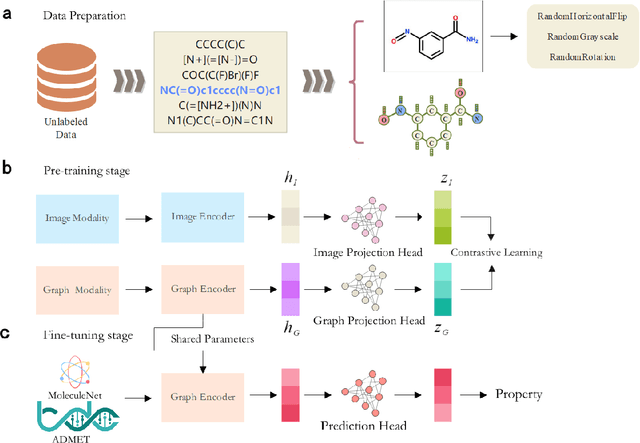
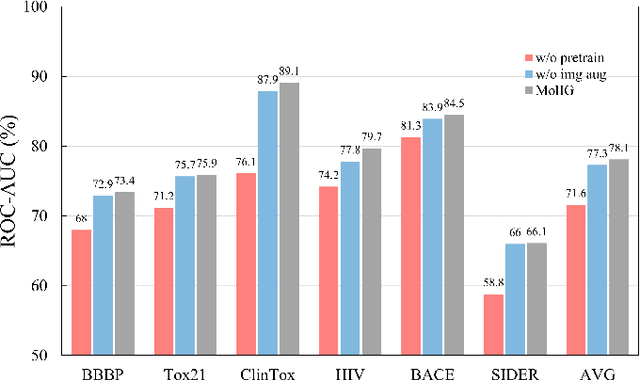
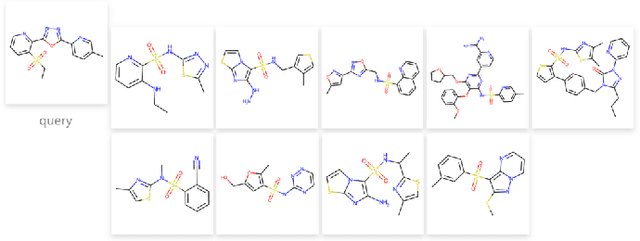
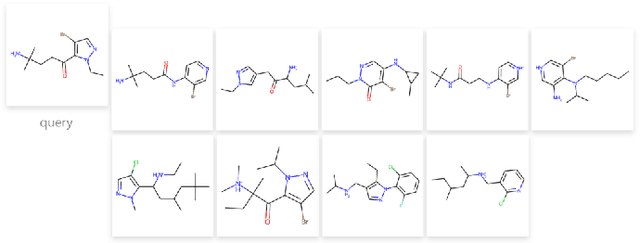
Abstract:The quest for accurate prediction of drug molecule properties poses a fundamental challenge in the realm of Artificial Intelligence Drug Discovery (AIDD). An effective representation of drug molecules emerges as a pivotal component in this pursuit. Contemporary leading-edge research predominantly resorts to self-supervised learning (SSL) techniques to extract meaningful structural representations from large-scale, unlabeled molecular data, subsequently fine-tuning these representations for an array of downstream tasks. However, an inherent shortcoming of these studies lies in their singular reliance on one modality of molecular information, such as molecule image or SMILES representations, thus neglecting the potential complementarity of various molecular modalities. In response to this limitation, we propose MolIG, a novel MultiModaL molecular pre-training framework for predicting molecular properties based on Image and Graph structures. MolIG model innovatively leverages the coherence and correlation between molecule graph and molecule image to execute self-supervised tasks, effectively amalgamating the strengths of both molecular representation forms. This holistic approach allows for the capture of pivotal molecular structural characteristics and high-level semantic information. Upon completion of pre-training, Graph Neural Network (GNN) Encoder is used for the prediction of downstream tasks. In comparison to advanced baseline models, MolIG exhibits enhanced performance in downstream tasks pertaining to molecular property prediction within benchmark groups such as MoleculeNet Benchmark Group and ADMET Benchmark Group.
 Add to Chrome
Add to Chrome Add to Firefox
Add to Firefox Add to Edge
Add to Edge